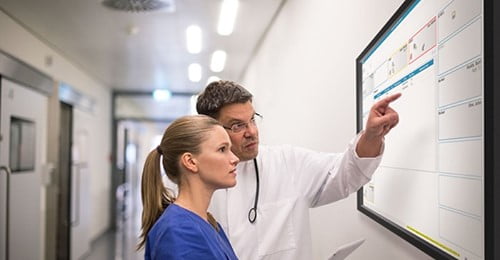Today’s electronic medical records (EMR) represents a large piece of how technology has made management of health information and care coordination possible, in more patient-centric ways, mostly within the boundaries of a hospital. Now, in the face of COVID-19, the industry is moving towards linking every aspect of healthcare, ensuring care professionals, caregivers and patients have access to all the patient information they need, wherever they need it. But we have a long way to go. In the fifth edition of Philips’ Future Health Index, 55% of US healthcare professionals believed better integration of healthcare data between hospitals and practices and their respective systems would have helped them leverage health data during the COVID-19 pandemic. There are a lot of lessons to learn from systems and processes that failed those responding to the pandemic, but one thing is for sure – frictionless access to data is at the heart of quality patient care.
The advancement of technology and the insights it provides is allowing us to break the silos that have traditionally made care coordination throughout a patient’s journey difficult. As healthcare facilities across the world are looking to improve both the patient and provider experiences, these are five trends we see dominating the discussion among CIOs:
Reinforcing focus on strategic value creation for healthcare organizations
Today’s CIO is hard-pressed to support the strategic objectives of their healthcare organization, while staying within their budget – which are expected to face increasing strain as a result of COVID-19 [1]. They’re actively seeking to invest in technology that’s cloud-based, and accessible via multiple platforms, both for business applications as well as health informatics applications. Why? This allows their teams to shift focus from maintaining the existing systems, to supporting more strategic goals with new patient engagement or telehealth program.
Engaging in modern business models when adopting technology
Keeping up with the rapidly changing technology landscape and increasingly complex IT industry requires engaging in innovative business models and true partnership with vendors to manage IT needs. Instead of a traditional model where a hospital may purchase and own technology outright, an increasing amount of healthcare CIOs are considering the Software-as-a-Service (SaaS) model for the procurement of their healthcare IT solutions, which keeps the ownership with the vendor, who will provide technical support, optimization opportunities, asset and data management, and so on. Overall streamlining of IT platforms and infrastructure is another key focus area, helping to ensure a consistent service experience and reduce the burden of maintaining various, disparate solutions.
It’s becoming evident that ensuring end users have access to the latest innovative capabilities is much more important than owning the technology and its infrastructure all together. It enables quicker adoption of new innovations, requires less major upfront costs, future-proofs operations, and importantly, it keeps the investments focused on the true value add – empowering staff to deliver the best possible care.
Proactively enabling care coordination across the health continuum
Health systems are looking to improve operational and clinical efficiencies by creating shared infrastructures. Cloud-based solutions securely break data siloes and free up information that both the patient and provider can benefit from.
We worked with one hospital in Rio de Janeiro, Hospital São Vicente de Paulo, that was struggling to control the life cycle of its patients’ prescriptions as effectively as possible. With our integrated EMR and working with doctors, nurses and pharmacists, the hospital fully digitized prescriptions for each patient, and as a result increased its capacity of treatment by 200% in just three years. They now control each prescription through its entire life cycle and can guarantee the delivery of the right drug at the right time, to the right patient, improving patient outcomes.
Deploying solutions that improve provider (and patient) experiences
US doctors work almost 60 hours a week and younger residents often work up to 80, enduring grueling 24-hour shifts at times. Long-term, unresolvable job stress leads to the exhaustion and burnout that affected 44% of physicians in 2019, according to Medscape’s annual report [2]. Adding to this, Philips’ Future Health Index found that 72% of healthcare professionals under 40 around the globe regularly experience work-related stress.
Administrative pressures often top the list of causes of physician burnout. Luckily, modern EMR solutions can help physicians to ease this burden. But we need to modernize user experience (UX) to make that happen. Consider a provider’s daily tasks while managing their patients – scheduling appointments, ordering and delivering medical services, managing patient rooms, and more. An advanced EMR streamlines these tasks. New platforms fully automate processes and make patient data readily available, allowing providers to improve care and see more patients.
Building systems of engagement
The trouble with traditional EMRs and other information systems has been their limitations as systems of record, or systems that simply host data. Becoming systems of engagement is what will ensure today’s IT solutions can provide real value. A system of engagement enables people to interact with their data, devices, and technology with ease. It liberates data from silos, enabling caregivers to easily extract valuable insights, take action and collaborate on care.
Another trend driving the evolution of EMRs is growing patient involvement in their own health. The next generation of healthcare IT solutions must be designed with both physician and patient expectations in mind. Nine out of 10 respondents to a recent survey said their organization now offers a patient portal, according to the Medical Group Management Association. The remaining 10% cited they are working to implement patient portals or have the software as part of their EMR but have not yet implemented it [3]. There is a clear trend: many patients are asking to be more engaged in their care journeys and to receive care even at home. Despite this growing engagement, health systems still need to be able to manage different types of patients and the wide spectrum of engagement. It is only through focusing on patient and provider engagement we can move beyond a system of record and towards a system of true insight – information that is streamlined for proactive care delivery.
Clinical data is more than just information – it’s a way for clinicians to improve health outcomes and for health systems to improve operations. Having the right clinical data at the fingertips of medical professionals, whether it is inside the hospital or at home, will drive better outcomes. Society’s greatest challenges are evolving and growing – the continued battle against the pandemic, aging populations and therefore an aging workforce, rising chronic disease, and the list goes on. Integrated health platforms aren’t the only piece of the solution, but these are something we can’t afford to ignore if we want to see measurable progress towards achieving the Quadruple Aim – better health outcomes, improved patient and staff experience, and lower cost of care.






